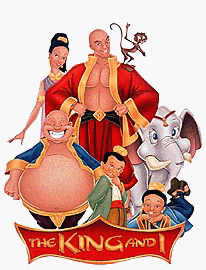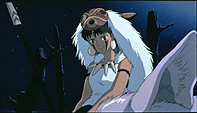While 1999's "different" animated features did not break any box office records, they did show that a change is in the air. Andy Klein illuminates the animated feature's struggle.
1999: It was the best of years; it was the worst of years. On the one hand, not only were there more first-rate animated features in the theaters than in any other recent year; there was a greater diversity of material. On the other hand, only a narrow range of that material brought people into the theaters; most attempts at really pushing the various envelopes that restrict popular animation were once again punished financially.

This Year's Contenders
Disney owned the year. (Big surprise.) Commercially, the first third was dominated by A Bug's Life (held over from the previous year); the middle third by Tarzan; the last two months by Toy Story 2. The first and third were, of course, Pixar productions and therefore not rigidly within the traditional Disney mold; even Tarzan represented a slight departure from what had been an increasingly conventionalized formula. (In the spring, the studio also had the less ambitious, and less successful, Doug's First Movie.) Most non-Disney releases didn't do as well, for a variety of reasons. The failure of Warner's The King and I is the easiest to diagnose. All one can ask is: What the hell were they thinking? Who did they imagine was interested in seeing an animated retread of one of the most egregiously dated hits of the Fifties? It's not merely the kids' audience that had no nostalgic interest; even most parents were too young to remember or care about the Rodgers and Hammerstein musical. Add to that the material's political implications, which were only slightly less thorny than 1997's Anastasia, and you have a project whose green lighting is an utter mystery.

But there were other, more troubling failures, as well as one troubling, if utterly predictable, success. The latter is, of course, Pokemon: The First Movie: Mewtwo Strikes Back. Coming in at the peak of a year's worth of frenzy among the nation's children, Pokemon was such a sure shot that even Warners couldn't mismarket it into oblivion. That said, one could argue that they did mismarket it. The bungling of their card giveaway suggested a complete misestimation of their audience; the film's extraordinarily rapid drop after its first week -- $50 million the first five days, $30 million for the rest of its run -- is either an indictment of the studio's long-term strategy for the film or a paean to their hit-and-run exploitation of a turkey that was soon killed by word of mouth. Most disturbing were the three films that represented real departures and still were disappointments at the box-office. The Iron Giant received probably the strongest reviews of any feature of any kind in 1999 and yet failed to break $25 million. Princess Mononoke, the first anime feature to be distributed by a major independent (Miramax), has had a lackluster performance. And although Paramount appeared pleased that South Park: Bigger, Longer & Uncut made a little over $50 million, one could argue that any live-action comedy with a built-in fan base and such strong reviews would have been considered a failure with that number.
Punished...
Each of these films, in different ways, strayed from the Disney formula more radically than Disney's own 1999 releases. Each was penalized at the box office either for being different or for the simple transgression of not being distributed by Disney. The latter two in particular represented attempts at targeting a relatively adult audience. The MPAA gave Mononoke a well-deserved PG-13 rating. South Park received an R and was, by usual MPAA standards, lucky not to have gotten stuck with the NC-17 it received on its first submission. Jack Valenti, the power behind the MPAA rating system, who never publicly challenges specific ratings, later said that the board had screwed up by not rating the movie NC-17. The film's attack on that very system obviously ruffled the usually dignified Valenti, who also referred to creators Trey Parker and Matt Stone as "those two hairballs." (Parker and Stone almost certainly would have had grounds for a restraint-of-trade lawsuit if the MPAA had slapped an NC-17 on a film that was essentially a critique of the MPAA.)
Indeed the MPAA may well be right that most parents would be appalled at their younger children seeing the obscenity-laden film. But would most parents really see much point in keeping their already obscenity-laden teenaged kids away from South Park? If so, then most parents should probably wisen the fuck up; as the film makes abundantly clear, a) it's too late, and b) potty mouth is not the worst sin in the world. Both films were just the latest examples of the age-old difficulty in marketing non-children's animation. Paramount's relative pleasure over South Park's box office reflected a resigned attitude: given the history and conventional wisdom surrounding such films, $50 million seemed like quite an accomplishment. All of this would reflect a crisis in the marketing of adult animation if it weren't such a familiar old story. It's been nearly three decades since Ralph Bakshi released the X-rated Fritz the Cat; but not all that much seems to have changed.

A Closer Look
The notion that animation is (for better or worse) almost entirely for kids is such a given that one is forced to stop and ask the simple question: Why?There is nothing in the form that should be inherently more appealing or more acceptable to kids than to adults. No one has ever suggested that still photography is inherently adult while non-photographic art is basically for kids. So why, in the realm of motion pictures, is the equivalent such a foregone conclusion?
The answer, I think, lies in a historical fluke of animation marketing. Within the popular consciousness, Disney in the Thirties and Forties so defined what an animated feature is supposed to be that animation became regarded more as a genre (which it really isn't) than as a medium (which it is). Certainly, in the eyes of the trades and of the studio marketing people, the word "animation" represents a genre. It is put on a plane with other content-determined genres such as mysteries, westerns, comedies, sci-fi films, even though an animated feature can also fit any one of those categories. Somehow "animation" has become synonymous with "animated children's film" or (in recent years) "animated children's film with show tunes, anthropomorphic animals and cute sidekicks."Within studio marketing departments -- and perhaps in the public's eyes as well, though that is more open for debate -- animation so thoroughly equals children's film that any breach of that convention is considered a challenge -- a challenge at which the studios regularly fail.

Inevitable Change?
If there is any difference now from the past, it is that the pressure toward adult animation is stronger than ever before. Fritz the Cat emerged from a genre of comic book that was never a mass phenomenon: the entire comix industry that R. Crumb defined (along with S. Clay Wilson, Gilbert Shelton, and a few others) never reached more than a small counterculture audience.
It was, however, part of a general cultural rebellion that eventually seeped over into the mainstream. The same relaxing of restrictions that brought the end of the Production Code, the increase in sex, violence and "language" on screen, and massive changes in the boundaries of public discourse has progressed since then, aided in no small part by technological changes.
Much as the invention of TV forced motion pictures to risk greater expressive freedom, so did the coming of cable change the face of TV. The networks weakened, making room for the wily upstart Fox; and Fox saw its best chance in the more "daring" material that started ignominiously with Married with Children and reached its qualitative apex with The Simpsons. Cable fought back with Beavis and Butthead and then with South Park -- both of which were able to push the standards more than any broadcast station, even Fox.
It was inevitable that this cultural change would leach over to the big screen.
Yet the very debates sparked by South Park are indicative of the blindered view that animation is by definition kid's stuff. The more extreme edge of this perspective -- as exemplified by groups like the Christian Action Project, whose online review of Bigger, Longer & Uncut was nearly as funny as the film itself -- sees nothing less than the deliberate use of "children's entertainment," i.e., animation, to corrupt the young and indoctrinate them in atheism, Satanism and all that is unholy.

The other pressure toward adult animation comes from Japan, where anime has long since taken animation beyond the range of young children. (One can only imagine what the Christian Action Project would have made of Urotsukidoji: Legend of the Overfiend.) There is no inherent reason to think that Princess Mononoke should have a harder time finding its audience than a live-action adult adventure film; yet Miramax has been unable to draw in audiences, despite yet another set of virtually unanimous rave reviews. It would be nice to think that the time has finally come for animation to break out of its children's straitjacket. But commercially speaking, this is not at all clear. I suspect that the problem lies not so much with the audience as with Hollywood execs, whose inherent conservatism makes adult animation seem both a risk and a bother. Only the respectable performance of Bigger, Longer & Uncut bodes well for the immediate.Andy Klein is a film critic for the New Times newspaper chain. He is head of the animation committee for the Los Angeles Film Critics Association (LAFCA).







